Lengthy identified to be a candy spot for cybercriminals, small companies usually tend to be victimized by ransomware than giant enterprises
18 Sep 2025
•
,
5 min. learn

Suppose your enterprise is simply too small to be singled out for digital extortion? Suppose once more. Certainly, in case you’re an SMB proprietor, you’d higher assume you’re a possible goal. Verizon knowledge reveals that, whereas ransomware contains 39% of knowledge breaches at giant organizations, the determine rises to 88% for SMBs. Massive enterprises could also be extra ready to pay multimillion-dollar ransoms, however they’re usually additionally extra more likely to have the instruments and insurance policies in place to stop, detect and include breach threat.
In the meantime, SMB are, very similar to giant firms, completely depending on their knowledge and IT infrastructure to function. The specter of everlasting knowledge loss and a complete enterprise shutdown has usually been a robust motivator for paying the ransom payment, even with none assure that the enterprise will truly get its knowledge again.
Making issues worse, attackers at all times search for extra levers to power fee, for instance through double-extortion assaults the place they each steal delicate knowledge and encrypt and threaten to publish it. Other than stealing and threatening to leak or wipe delicate inside knowledge, they could threaten DDoS assaults, regulatory complaints and, oddly sufficient, even bodily violence in some circumstances. In actual fact, attackers even fortunately alter their ransom calls for to extend the percentages of a fee, as discovered by Verizon.
To place it bluntly, less-well defended SMBs are a juicy goal for attackers. Certainly, by having extra digital property and cash than customers and fewer cybersecurity protections than enterprises, these companies have for lengthy been in a “cybercrime candy spot”. When you’re eager to maintain your organization’s knowledge secure and techniques safe, the excellent news is that it’s achievable with out breaking the financial institution.

How ransomware teams are evolving
To sort out the risk, you additionally want to know who or what’s driving it, and the way it’s altering. For one factor, the ransomware-as-a-service (RaaS) industrialization of cybercrime has lowered the boundaries to entry and facilitated the proliferation of ransomware. In the meantime, the turnover of ransomware manufacturers additionally continues apace, brought on partially by intensifying regulation enforcement efforts. As quickly as a bunch is taken down, a brand new one usually emerges with related or different ways and instruments in a bid to flee scrutiny. Moreover, fast-evolving TTPs make it tougher to mitigate threat.
Alternatively, ransomware rebrands may be a mirrored image of the difficulties many teams are having in turning a revenue. An evaluation of cryptocurrency ransom funds reveals a 35% lower between 2023 and 2024. But confronted with probably fewer victims prepared to pay, ransomware teams seem like doubling down on those that do, as proven by a examine claiming that 55% of organizations that paid a ransom final yr did so a number of instances; with 29% paying three or extra instances.
How AI is remodeling ransomware
As expertise advances, ransomware teams are additionally altering tack to extend their probabilities of success. The same old methods to realize preliminary entry into sufferer networks stay vulnerability exploitation, phishing and distant entry compromise; akin to through credentials obtained by infostealer malware. But AI instruments may supercharge all of those efforts.
The UK’s Nationwide Cyber Safety Centre (NCSC) warned not too long ago that over the following two years AI use will result in “a rise in frequency and depth of cyber threats.” Scanning for weak victims (reconnaissance), vulnerability exploitation, and social engineering particularly will develop into extra democratized on the cybercrime underground.
In the meantime, ESET not too long ago found what’s believed to be the world’s first AI-powered ransomware, “PromptLock.” It makes use of a authentic mannequin from OpenAI to generate malicious scripts. “The prospect of AI-powered malware that may, amongst different issues, adapt to the surroundings and alter its ways on the fly could usually symbolize a brand new frontier in cyberattacks,” ESET warns.
A separate ESET report highlights different new developments together with the looks of “EDR killers” – designed to terminate, blind, or crash endpoint detection and response (EDR) tooling put in on sufferer techniques. Teams have additionally been noticed utilizing “ClickFix” social engineering ways to trick customers into putting in malware on their machines.
shield your enterprise
A handful of SMBs know to their value what can occur following a ransomware breach. Though already underneath monetary strain earlier than a 2023 assault, British logistics agency KNP subsequently fell into administration with the lack of 700 jobs.
To stop your enterprise going the identical method, undertake a prevention-first mindset by:
- Deploying strong patch administration to make sure vulnerabilities deemed the very best threat are patched, to additional restrict the chance for preliminary entry and lateral motion.
- Updating id and entry administration insurance policies and tooling in keeping with a Zero Belief method. This implies assuming breach, steady verification of customers, least privilege insurance policies, and multi-factor authentication.
- Making certain safety software program from a trusted vendor is positioned on all gadgets, from endpoints, servers to distant employee laptops.
- Backing up delicate information based on trade greatest practices, in order that even when information are encrypted they are often restored, lowering your adversary’s leverage.
- Devising an incident response plan in collaboration with key stakeholders from throughout the enterprise. It must also be examined periodically to make sure it’s match for objective in serving to to speed up containment following an intrusion.
- Repeatedly monitoring your networks, endpoints and different elements of the IT surroundings for indicators of suspicious habits. These early warning indicators ought to assist to reduce attacker dwell time.
- Updating coaching and consciousness programs to incorporate simulation workouts that includes the newest phishing ways, together with voice-based phishing (vishing). Your staff are each your greatest asset and your weakest hyperlink.
Importantly, be certain to correctly consider your property, sources and dangers, together with these emanating from provide chains. Maintain a listing of all open-source and proprietary off-the-shelf instruments utilized by your group. Extra broadly, asset visibility is the inspiration of any threat administration program. In different phrases, attackers are identified to rely on blind spots. When you don’t know a system exists or what knowledge it holds, you possibly can’t shield it.
Because the ESET SMB Digital Safety Sentiment 2022 has proven, many SMBs are more and more conscious of ransomware and different dangers going through their enterprise, however they don’t have the boldness of their in-house cybersecurity experience. It is smart then that lots of them, particularly these with fewer sources, are more and more turning to managed detection and response (MDR) providers to and hand off the monitoring to an skilled companion who then performs 24/7/365 risk searching, detection and response, lowering the operational burden in your in-house crew whereas making certain any ransomware exercise is quickly recognized, contained and eradicated. Ransomware actors have to be despatched packing earlier than they’ve an opportunity to trigger any injury.


